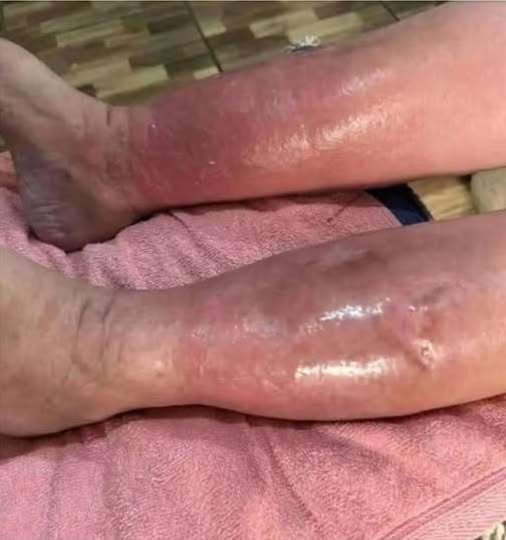Your feet may not always get much attention, but doctors emphasize that they can often reveal the earliest warning signs of deeper health problems. Changes in your feet can point to conditions like diabetes, thyroid issues, heart disease, and poor circulation, and noticing these signals early can sometimes prevent serious complications.

One of the first indicators comes from your toenails. Spoon-shaped nails, medically known as koilonychia, curve upward and can hold a drop of liquid. This condition is frequently linked to iron-deficiency anemia, where low iron levels impact oxygen transport and nail development, but it can also appear in connection with heart disease or disorders like hemochromatosis, where the body absorbs too much iron. If you notice spoon nails alongside symptoms like fatigue or pale skin, it’s time to seek medical advice. Yellow or thickened toenails may seem like a minor nuisance, but they can mean more than just a fungal infection.
Such changes sometimes point to thyroid problems, psoriasis, or compromised immunity as seen in conditions like diabetes or HIV. In persistent cases, they could also be a sign of yellow nail syndrome, which is connected to lymphedema and respiratory issues. Another serious warning is dark streaks or lines under the nails, which might be caused by trauma but, in the absence of injury, could indicate subungual melanoma, a rare and dangerous type of skin cancer.
Because this cancer is often detected late, any unexplained streaks should be examined by a dermatologist right away. Your skin, too, can offer clues about your health. Chronically cold feet may seem harmless but are often linked to poor circulation, peripheral artery disease (PAD), or hypothyroidism. PAD is especially risky for older adults, smokers, and people with diabetes, as it narrows arteries and reduces blood flow. Red or purple discoloration in the feet can point to vascular disease or venous insufficiency, which may also cause varicose veins, swelling, or even ulcers. Dry, cracked skin, particularly around the heels, can signal thyroid problems or diabetes-related nerve damage. Cracks also make the feet vulnerable to infections such as cellulitis, which can spread quickly if untreated. Sensations like tingling, numbness, or burning pain are also significant warning signs.
Numbness and tingling in the feet are often early symptoms of diabetic peripheral neuropathy, where high blood sugar damages nerves, sometimes leading to ulcers and infections because injuries go unnoticed. Burning sensations may be tied to alcohol abuse, vitamin B12 deficiency, kidney disease, or small fiber neuropathy, a type of nerve damage that can be hard to detect through standard tests. Frequent cramping in the feet and toes could indicate dehydration, circulation issues, or an electrolyte imbalance involving potassium, calcium, or magnesium. These cramps may worsen at night or after exercise and are sometimes related to medications like diuretics. Swelling in the feet and ankles, also known as edema, is another symptom not to ignore.
While swelling can occasionally be benign, persistent or unexplained swelling may point to congestive heart failure, kidney disease, or liver disease. Bilateral swelling often suggests systemic illness, while swelling in one foot may suggest a deep vein thrombosis, which is a medical emergency if accompanied by chest pain or shortness of breath. Non-healing foot ulcers are a red flag for poor circulation and nerve damage, especially in people with diabetes. These sores can quickly become infected and, if ignored, may result in amputation. Sudden, sharp pain in the big toe is often linked to gout, a form of arthritis caused by uric acid buildup.
Gout flare-ups are often triggered by diet, alcohol, or dehydration and can eventually cause joint deformities if untreated. Physical deformities such as bunions and hammertoes are sometimes dismissed as cosmetic or footwear-related issues, but they can worsen with underlying arthritis, particularly rheumatoid arthritis, which may deform joints in both feet and impair mobility. In some cases, surgery becomes necessary when conservative treatments fail.
Even hair loss on the toes can be an important signal, as it may indicate poor circulation associated with PAD, often accompanied by shiny skin and weak pulses in the feet. Knowing when to see a doctor is critical. Warning signs like persistent swelling, nail discoloration, dark streaks under the nails, non-healing sores, burning or tingling sensations, or sudden severe foot pain all warrant medical attention. Taking preventative steps can also make a big difference: check your feet regularly, keep them clean and moisturized, wear properly fitting shoes, monitor blood sugar if you have diabetes, maintain healthy cholesterol and blood pressure, and avoid smoking since it worsens circulation.
Annual foot exams are especially important for people with chronic conditions. The bottom line is that your feet can tell you a lot about your health if you know what to look for. Ignoring these subtle but meaningful signs could allow serious conditions to progress silently, but paying attention gives you the chance to intervene early. Caring for your feet isn’t just about comfort—it’s a key step in protecting your overall health.





